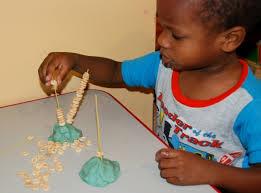Every parent dreads the moment when their three year-old shows them his or her nice new haircut, and proudly states it was done, “All by myself!” Where did they get those scissors anyway? And, what about the child’s desire to pick their nose (Ew, gross!)? Relax parents, your child is simply working on her or his fine motor control skills.
Fine motor control is the coordination of muscles, bones, and nerves to produce small precise movements in the fingers, hands, and toes. These skills allow young children to pick things up, hold things, and maintain balance. Humans develop fine motor skills at a young age, typically right along with gross motor skills—the use of large muscles to control one’s body—such as crawling and walking.
Fine motor control is the basis for day-to-day functioning. Children’s fine motor coordination enables them to groom themselves, to write, to play with other children, and much more. Parents, you can do many things to facilitate your child’s development of these important fine motor skills. These skills will be helpful to your child as he or she enters school.
What You Can Do to Promote Your Child’s Fine Motor Control
Infants
Parents, you can provide opportunities for your infant to explore through touch. Remember though, the safety of your baby is your highest priority so never leave him or her alone with any objects or materials not safe to touch or chew on. This includes objects with sharp edges or loose small parts.
Exploring includes handling different kinds of objects and materials. Your child can touch and feel the different textures of different materials, or you can rub them on your baby’s feet and belly. Allowing your baby to put safe chewing toys in his or her mouth helps them develop the coordination to do self-help activities. The more chances your baby has to explore, the more she or he has opportunities to develop their small muscles.
Toddlers and Preschoolers
Like infants, toddlers and preschoolers are curious; unlike infants, however, they are mobile and will actively seek opportunities to explore their environment. They will grab anything within reach, so you still need to be watchful. You can provide your child with objects, like Legos to pick up, explore, and assemble. As your child gets older, you can provide a variety of activities for him or her to continue developing fine motor skills:
- Introducing writing tools such as pencils, markers, and crayons
- Popping bubble wrap with their index finger and thumb
- Finger-painting
- Drawing with sidewalk chalk
- Constructing jigsaw puzzles
- Stringing large beads (or Cheerios) onto a string
- Tracing shapes, drawing, and coloring
- Using child-safe scissors to cut
- Throwing, catching, and kicking balls
- Manipulating clay or play dough
- Brushing their teeth on their own
- Using pipe cleaners for activities
- Turning the pages of a book
- Doing household chores: Wiping, sweeping, picking up toys
- Using tweezers to pick up small items
- Using a spoon and fork for eating
- Sorting blocks with shapes-sorter
- Playing with hair ties or Velcro
- Using clothespins in activities
- Dressing and undressing on their own
- Fastening buttons and zipping up zippers
For additional information and activities to promote your child’s fine motor development, visit The Imagination Tree or Mama OT.




